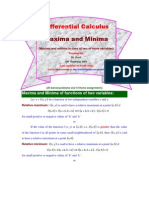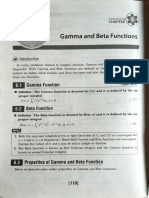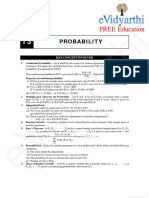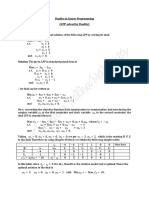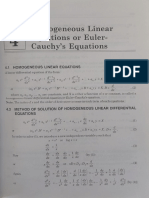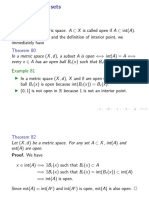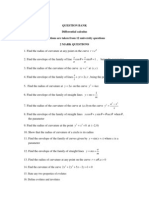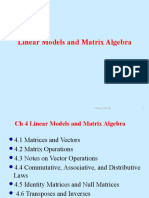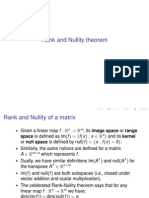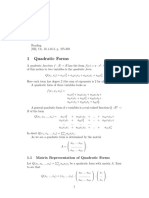0 ratings0% found this document useful (0 votes)
279 views17 pagesch-5 Duality in Linear Programming
Uploaded by
AkhilCopyright
© © All Rights Reserved
We take content rights seriously. If you suspect this is your content, claim it here.
Available Formats
Download as PDF or read online on Scribd
0 ratings0% found this document useful (0 votes)
279 views17 pagesch-5 Duality in Linear Programming
Uploaded by
AkhilCopyright
© © All Rights Reserved
We take content rights seriously. If you suspect this is your content, claim it here.
Available Formats
Download as PDF or read online on Scribd
You are on page 1/ 17
Duality in Linear Programming
“Man is simply 10 recognise that there are different approaches for solving problems”
5:1. INTRODUCTION
Associated with every linear programming problem (maximization or minimization) there always exist
another Linear Programming problem which is based upon the same data and having the same
solution. The original problem is called the primal problem while the associated one is called its
dual problem. It is important to note that either of the two linear programming problems can be
tweated as primal and the other as its dual. The two problems, thus, constitute a primal-dual pair.
The concept of duality is based on the fact that any linear programming problem must be first put
in its standard form before solving the problem by simplex method. Since, all the primal-dual
computations are obtained directly from the simplex table, it is logical that we define the dual that
may be constituent with the standard form of the primal.
($2 GENERAL PRIMAL-DUAL PAIR
Based on the standard form of primal, there are two important primal-duial pairs :
Definition 1. (Standard primal problem)
Maximize z= c)x; + €2%z +... + CyXq subject to the constraints +
xy + Qk, + oon + Uinky = By
4205
Dual Problem
Minimize 2* = byw, + byw; +. + by Wy subject to the constraints :
ayy + yyy + one + Oy Wy 2 655
w; (= 1, 2... m) unrestricted
are the primal variables, w,’s the dual variables and the other constants have their
Note that
usual meanings.
Definition 2. (Standard primal problem)
Minimize z= ¢)X) +,¢2%z +. + Cy%q Subject to the constraints :
bs i
FFL Bown
aya, + apr, + on. + dint
a
Dual Problem 3
Maximize 2 = bjw; + b2W, +... + DyWy subject t0 the constraints :
yw, + dyyWy + oa. + yy Wy S C3
w; (i = 1, 2, ....m) unrestricted.
Scanned with CamScanner
ee
q
130 OPERATIONS Res:
ARCH
Remark. From the above definitions one may easily observe the following:
there is a dual variable.
(a) For every primal constraint
(b) For every primal variable, there is a dual constraint
(6) The coefficients of the dual variables in the const
primal variables except that they are transposed, i... columns im pri
rows in the dual coefficient matt,
(a) The number of dual constraints is exactly equal to the number of primal variables. whereas the
number of dual variables is exactly equal to the number of primal constraints.
(e) The objective coefficients of the primal variables become the right-hand side cont tte of dual
vsasinte whereas the right-hand side constants of the dual constraints become the objective
coefficients of the primal problem.
The information regarding the primal-dual objective,
variables may be summarized in the following table :
Itints are the same as the coefficients of the
nal coefficient matrix become the
type of constraints and the signs of the dul
Standard primal ~ ‘Dual
objective Objective Constraints Variables
‘Maximization ‘Minimization 2 Unrestricted
Minimization Maximization s Unrestricted
f
. FORMULATING A DUAL PROBLEM
Various steps involved in the formulation of a primal-dual pair are >
Step 1. Put the given linear programming problem into its standard form. Consider it as the
primal problem.
Step 2. Identify the variables to be used in the dual probl
equals the number of constraint equations in the primal.
Step 3. Write down the objective function of the dual, using the right-h
primal constraints.
If the primal problem is of maximization type,
vice-versa.
Step 4. Making use of dual variable identified in Step 2, write the constraints for the dus!
problem.
(a) If the primal is a maximization prob’ m, the dual constraints must be all of “2° type. Ife
primal is a minimization pfoblem, the dual constraints must be all of ‘<" type.
“(b) The column coefficients of the primal constraints become the row coefficients of the du
constraints.
(c) The coefficients of the primal objective function becomes the right-hand side constants of
dual constraints.
(d) The dual variables are defined to be unrestricted in sign.
Shep 5. Using steps 3 and 4, write down the dual of the given L.P.P.
lem. The number of these variables
and side constants of the
the dual will be a minimization problem and
yf the:
‘Note : ‘The dual constraint corresponding to an artificial variable in the standard form of the primal is
always redundant, heuce it is never necessary to consider the dual constraint associated with an
artificial variable.
Remarks, 1. If the given linear programming problem is in its eanonical form, the primal-dual pat is
said to be symmetric. ;
Fit the given linear programming problem is in its standard form, the primal-dual pair is said to be
unsymumetric.
Scanned with CamScanner
DUALITY IN LINEAR PROGRAMMING
131
5:4, PRIMAL-DUAL PAIR IN MATRIX FORM
ndard Primal Problem
Definition 1. (Standard primal probl ind x7 © Re
La ne contra fem). Find xT © RY so as to maximize z= ex, ¢€ RY
Ax=b and x20, bT Rm
where A isan mxn real matrix,
ual Problem. Find w? eR” ae .
D ind WT © R so as.t0 minimize 2x = blw, be RM subject to the constraints :
a Alw 2 cl ce RY ‘
where AT is the transpose of an mn real matrix A and w is unrestricted in sign,
Definition 2. (Standard primal problem). Find x7 € R" so as to minimize
subject to the constraints : = ex, ce RY
; Ax=b and x20, ble RM
where A is an mXn real matrix,
ind wT @ Re ;
Dual Problem. Find w" € RY, so as to maximize 2 = bTw, b € RM subject to the constraints:
uv i Alw scl ce R"
where AT is the transpose of an mn real matrix A and w is unrestricted in sign.
SAMPLE PROBLEMS
$0 Formulate the dual of the following linear programming problem :
v Maximize z = 5x, + 3x, subject to the constraints :
3xy + Sky $ IS, Sxy + 2xz $10, x) 20 and xy 20.
Solution. Standard Primal, Introducing slack variables s, 2 0 and s 2 0, the standard linear
programming problem i
Maximize z = Sx, + 3x + 0's, + O's, subject to the constraints :
Bry + Say + 51 + Og = 15, Sxy + 2ey + O51 + 52 = 10, xp, xy 51. 52 20
Dual. Let w, and w, be the dual variables corresponding to the primal constraints. Then, the dual
problem will be :
Minimize z* = 15w, + 10w, subject to the constraints :
Bw, + Sw 25, Sw) + 2) 23
Ww, + Ow, 20 o
jy, 8 ae Op w, 20 and. w = 5
w and w, unrestricted (redundant).
‘The dual variables “Ww, and w, unrestricted” are dominated by w, 2 0 and w, > 0, Eliminating
redundancy, the restricted variables are w, 2 0 and w, 2 0.
(2. Write the dual of the L.P.P. : :
Minimize. z = 4%) + 6x, + 18%; subject to the constraints
xy + 3xq 23, Xp + 2p ZS-and xp, xy xy 2 0. [Delhi B.Sc. (Stat,) 2006]
Solution. Standard Primal. Introducing surplus variables s, 2 0 and s,°2 0, the standard form of
the L.P.P. is:
Minimize z
xy + Bry — 5) = 3s Oxy + ap + ty - =
Ax, + 6x + 18x, + 0-5, + 0-5, subject to the constraints
Xp Age Be Sy 82:20
ATTN A
Scanned with CamScanner
E s
32 OPERATIONS RESEARCH
Dual. If, and wy be the dual variables corresponding to each primal constraint. the dual
problem will be
3w, + Sw subject to the constraints +
Maximize z*
wy + Oy $4, Buy + wy $6, Owe + 22 S 1B:
wy, + Oo $0, and Ow - w2 5%
w, and wy unrestricted (redundant).
Eliminating redundancy, the dual problem is :
Maximize zt = 31, + 502
wy $4, 3wy + wy $6, 2og S185
. aa ramming problem:
503, Write the dual ofthe following lear Pre Te constants:
/S Minimize 2 = 3x, ~ 2x2
xy + Sry + 43 27 Oxy + 32+ Ses 24
Ixy ~ 2x — 3 $10, ay — 2x + SH 2S
fxy + 7xq — 2x3 22, 4 2H 4g 20, 120
Solution. Standard Primal. Introducing surplus variables 1 20, 2 20 42
slack variable s, > 0, the standard form of L-P.P. is : : =
Pye 3x, — Dey + Any + 05, + OS + Oe + Os subject to the constraints :
aint :
subject to the constr
0.
w, 20 and 22
0, ss 2 0 anda
Minimize z
3x + 5m + 45-1 = 7
6+ mt3g-2=4
10
Tx -2n- t=
ay - 2a + Sty - 54 = 3
Ary + Trg - 2x3 - 55 = 2
20.
is Xp 236 Sts Sos Sh St $5
ponding to the five primal constraints
3, 4, 5) are the dual variables corres}
standard primal L.P.P. is :
+ 2ws subject to the constraints :
Dual, If w,(j = 1, 2
in the given order, the dual of the st
Maximize zt = 7w, + 4w, + 10w, + 3¥%
Bw, + wy + Tws + wy + dws $3
Sw + Wz — 2ws ~ 2Wg + Tws S -2
4wy + 32 - Wy + Sy — 2ws S 4
wy $0, =, $0, w $0, — my $0, ws $0
w= 1 23,4, 5) ate unrestricted in sign.
Eliminating redundancy, the dual variables are : w, > 0, w, 2 0, ws $0, ws 2 O and ws 2 0.
Note. In the primal, if we multiply the third constraint throughout by —1, the dual variable w3 will be 2 0
insteadof < 0.
/;
504/ Obtain the dual of the following LP.P. :
_/ Maximize % = 2x, + 3x, + x; subject to the constraints :
dry + 3iy +45 = 6 a 42mg + SR = 45 Xp Xp 520 Madras BE. 19)
Solution. Clearly, the given linear programming problem is in stai idering i
standard primal, its dual is : indard form, Considering it as
Minimize 2*
4wy + Wz 22, 30, + 2wy 23, wy + Sw2 21; wy and wy are unrestricted,
where w, and w, are dual variables. ,
6w, + 4 subject to the constraints :
Scanned with CamScanner
SW ~
DUALITY IN LINEAR PROGRAMMING 133
505, Obtain the dual problem of the following primal problem :
Minimize z = x; ~ 3x, ~ 2x, subject to the constraints :
Bxy - x2 + 2x3 S 7, 2ey - dey 2 12, 4x) + 3xy + Bxy = 10
X42 20 and x; is unrestricted, [Delhi B.Sc, (Stat.) 1995}
Solution. Standard Primal. Introducing a slack variable s, 2 0 and a surplus variable 5, 2 0, the
primal problem is restated as
Minimize z = ex subject to the constraints : Ax
where x = [ty 254" sy he = (1, -3, -2, 2,0, 0), b
3-1 221 «0
2 -4 0 0 0 -1}, when x3 = ay - 345”.
4°38 80 0
Dual. If w = (wy, wz, ws) are the dual variables, the dual problem of the prima
Maximize z* =
b and x20,
(7, 12,10] and
A
Tw + 12Ww, + 10w; subject to the constraints :
Biv, + 2wy - 403 S 1
. = Wy = dey + By S—3 > wy + 4g — 3s 23
2m, + 8wy S-2
=2w, - 83S 2
wy $0
-w, 50
wi. w2 and w3 unrestricted.
Eliminating redundancy, dual variables are w, < 0, w, > 0 and ws unrestricted. This is re-written
as follows :
} 3 -2m ay = 2
Jomso and w) > 0
Maximize z* = 7w, + 12w + 10w, subject to the cons
Buy + avy — 4¥y S 1, wy + 4g — 303 2 3, —2wy - Bw,
ts:
wy $0 and wz 20, wy unrestricted.
Note. In the primal, if we multiply the first inequation by -1; the dual variable w; will be 2 0 instead
of $0.
PROBLEMS
Formulate dual of the following L.P.P.
(@) Maximize z= 4x, + 2x, subject to the constraints :
x) +23 4-42-25 20 and 20. (Annamalai MBA. (Nov.) 2009)
(6) Maximize z = 2000x + 3000y subject to the constraints :
Gx + 9y $100, 2 + y $20; x20 and y20, (Osmania M.BA. (Sept.) 2001)
50J-Formulate the dual of the following L.P.P. :
Maximize z = 10x, + 8x2 subject to the constraints : ‘
ay + 2ey 2S, 2p EIA Ky HID e A
x, 20 and x; is unrestricted, [Osmania M.B.A. 1999)
‘S08. Obtain the dual problem of the following L.P.P.
Maximize f(x) = 2x) + Sxq + Gry. subject to the constraints :
Sey + 6%; — ay $3, -24 ty tae $4, Sy +H AQ SL,
3k = By + Try $6 ay ty ay 20.
Scanned with CamScanner
134
/ OPERATIONS egg,
Find the dual of the following Lp.p, :
Maximize
te lys A subject to the constraints
NSH SI ay 4 ay
0, ‘ 4 unrestricted
510. Obtain the ys dy sm: ge and 4, unreste
in the dual of the following linear Programming problem
Maximize
2416 Bey + gy subject ta the constraints
1 MOM, Hy Oy Ody Sy
1, Obtain the dual problem of the following LPP,
Maximize z= xj ~ 2x + Bey subject tthe constraints:
= 2 +
420.
Madre HE, yy
tay 2 dey ede 6 ey BE tae ty 2
S12. Obtain the dual of the following finear programming problem :
Minimize z= xy + ty + xy subject to the constraints :
ay = ny 6 Any Sy 2g 3, Beh
44. % 2:0 andy unrestricted. [Garkwal M.Sc. (Mat) rp,
513. Give the dual of the following L.P.P. +
Minimize z= 2x; + 3xq + 4ry subject to the constraints =
2 tI S22 Ite Iya 4 4 4g + OH SS
yy 422.0 and xy is unrestricted.
S14. Maximize z = Gx, + Gr +43 + Tg + Sts subject (0 :
fey # ey + ty 6 Seg ry 2 Dey Hay t Udy + Ot + 9 =
sy Ap ty My 20, 5 unrestricted,
5 DUALITY THEOREMS
Theorém S41. The dual of the dual is the primal.
Proof. Let the primal L.P.P, be to determine x7 € R" so as to
Maximize f(x) = ex, ¢ € RY subject to the constraints :
Ax=b and x20, ble R"
where A is an m x1 real matrix.
The dual of this primal is the L.P.P. of determining w” € RM" so as to
Minimize f(w) = b’w, b’ € R” subject to the constraints :
ATw 2 c7, w unrestricted, ¢ € RY,
Now, introduce surplus variables s 2 0 in the constraints of the dual and write w = w; -™%>
where w, 2 0 and w, 2 0.
The standard form of dual then is to
Minimize g (w) = bT(w, ~ w;
bY € R™ subject to the constraints
AT(w, - 2) - 1,8 = 07, ce R"
wy, wz and s 2 0,
Considering this linear programming problem as our standard primal, the associated dual proble™
will be to
Maximize f(y) = ey, ¢ € R" subject to the constraints :
(ANTY SDT), <(AT YY s -bhy, :
-y $0 (=> yz 0) and y unrestricted,
ad
Scanned with CamScanner
135
DUALITY IN LINEAR PROGRAMMING
Eliminating redundancy, the dual problem may be re-written as :
Maximize f(y) = cy, ¢ € R" subject to the constraints =
Ay sb
aye) = Ay=b, bre R”
y20.
‘This problem, which is the dual of the dual problem, is just the primal problem we had started
with.
‘This completes the proof.
aid 52 (Weak Duality Theorem). Let x, be a feasible solution to the primal problem
Maximize f(x) = ex subject to: Ax c? and Bote” 2 0.
Now, if we let B+! c,” = w,, the above become
ATW, 2 cT and wy 2 0, Wo’ € R".
This means that w, is a feasible solution to the dual problem. Moreover, the corresponding dual
objective function value is,
yo
for all j
(in matrix form)
bl w, = wT b = eg Bb = cg Xp = Xo
Thus, given an optimal solution x, to the primal, there exists a feasible solution w, to the dual
such the ex, = b’w,.
Similarly, starting with w,, the existence of x, can be proved.
Corollary. f/x, is an optimal solution to the primal, an optimal solution to the dual is given by
W, = B+ ep, where B is the primal optimal basis.
Note, Obserye that B-! ep represents optimum z; - cj under primal slack columns.
theorem $45 (Fundamental Theorem of Duality). If the primal or the dual has a finite optimum
sofution, then the other problem also possesses a finite optimum solution and the optimum values of
the objective functions of the two problems are equal.
Proof. Consider the primal-dual pair
Primal. Maximize f(x) = ex subject to: Ax Sb and x > 0.
Dual. Minimize g(w) = b’w subject to: ATw >" and w>0.
(Necessary condition). Let a feasible solution x, (w,) be an optimum solution to the primal (dual)
problem. It then follows from Theorem 5-4 that there exists a feasible solution w, (x) to the dual
(primal) problem, such that ex, = b w,.
It now follows from Theorem 5-3 that w, must be optimal, ,
This proves the necessity of the condition.
nee It follows from Theorem 5-3.
Atheorems$6 (Existence Theorem), If either the primal or the dual problem has an unbounded
objective function value, then the other problem has no feasible solution,
_ Proof. Let the given primal problem have unbounded solution. Then for any value of the
objective function, say +0», there exists a feasible solution say x yielding this solution, is
cx — ex, If possible, let the dual problem have a feasible solution. Then from Theorem 5-2, for each
feasible solution w, of the dual, there exists a feasible solution x, to the primal such that
€% S bY w,, That is, bY w, —> e. Now as b is constant and w, has to satisfy the constraint
‘ _
Scanned with CamScanner
DUALITY IN LINEAR PROGRAMMING “7
ar My % e% therefore the dual objective function b’w, must be finite. This contradicts the result
bé'w, — ©. Hence the dual problem has no feasible solution. i
By a similar argument it can be sho bounded solution, the
Rey ale aaa shown that when the dual has an unboun
Standard results on duality can be
primal
Dual problem
Feasible Solution _
No Feasible Solution
In the following section we shall see how the above existence theorem helps us in
the relationship between the optimum values of the primal and dual variables.
Dual Unbounded
Unbounded or Infeasible
understanding
5:6. COMPLEMENTARY SLACKNESS THEOREM
em 5-7 (Complementary Slackness). Let x, and w, be the feasible solutions to the primal
{ max. e'x | Ax Sb, x 20) and its dual { min, btw | Alw 2 cl, w 20} respectively. Then, a
is is that
necessary and sufficient condition for x, and w, 10 be optimal to their respective probler
wa (b = Ax) £0 and xF(Alw, = ef) = 0.
Proof, Necessity. Let a = w,'(b - Ax) and B = x,"(AMW, ~ 6%). Since Xp Wy are feasible
solutions to the primal and dual respectively, we have
a20, B20 and at+Pew,'b- xe
0. But since ct 2 O and i > 0, this
Now, if x» ®, are optimal, then ex, = b'w, so that a + B
gives a = O and B = 0.
‘Thus the conditions are necessary.
Sufficiency. Let the given conditions hold for the feasible solutions x, and w,. That.is, a = 0
and B = 0.
Then O- a+ Pawth- xfer
= cx, = DP
= x, and w, are optimal,
Thus the conditions are sufficient,
Corollary 1. If x° and w° be feasible solutions to the primal and dual problems respectively, then
they will be optimal if and only if
we Fairy = 0 fen
PCE ae? ~ a
and jet
Proof, From the above theorem, x° and w° will be optimal, if and only if
wol(b - Ax) = 0 and x,7(€" ~ ATw,) = 0.
Consider the first set of conditions. Since each term in the summation w,"(b ~ Ax, is
non-negative, it follows that
= Fags) = 0,
Scanned with CamScanner
|
1
38 OPERATIONS RESEARe,
Similarly, the second set of conditions is equivalent to
Jeb
al
orollary 2. For optimal feasible solutions of the primal and dual systems, whenever the jy
variable is strictly positive in either system, the ith relation of its dual is an equality, "
Proof. It follows from corollary 7, that
wer 0a E ayxp = (ith primal relation)
and a9 > 0 => E ain?
th dual relation
Corollary 3. For optimal feasible solutions of he primal and dual systems, whenever ith relation
A either system 1s satisfied as a strict inequality, then the ith variable of its dial vanishes,
Proof. If follows from corollary J that
ayxP we =0
and E ayw? > 6 > xP =0.
i a
Remarks. The conditions of corollary 1 can also be written as
WP ty = 0
and 9. = 0
where ¥y41 is the ith slack variable in the primal problem and Wj iS the jth surplus variable in the
dual,
Thus, the theorem relates the variables of one problem to the slack or surplus variables of the
other. The above relations are called ‘complementary slackness’ because they imply that whenever a
st DUALITY AND SIMPLEX METHOD.
Since any L.P.P. can be solved by using simplex method, the method ig applicable to both the primal
as well as to its dual. The fundamental theorem of duality suggests that an optimum solution vo te
associated dual can be obtained from that of its primal and vice versa.
If primal is a maximization problem, then following are the set of rules that govern the derivation
of the optimum solution :
Rule 1. Corresponding net evaluations of the starting primal variables
= Difference between the left and right sides of the dual constraints associated with
the starting primal variables.
Rule 2, Negative of the corresponding net evaluations of the starting dual variables ‘
= Difference between the left and right sides of the primal constraints associated
with dual starting variables:
Rule 3. If the primal (dual) problem is unbounded, then the dual (primal) problem does not have
any feasible solution. be
Note. In rule 2, dual problem is to be solved by changing the objective from minimization to the
maximization.
: ‘Scanned with CamScanner
DUALITY IN LINEAR PROGRAMMING 199
. SAMPLE PROBLEMS
515,Ose duality to solve the following LP.P. :
, Ae = 2t, + xy subject to the constraints ¢
Hy + 2xy $10. 5) + xy $6, xy ~ 22 $2 ay - WH ST tH ZO
[Delhi B.Sc. (Stat.) 2006)
Solution. The dual problem of the given primal is
Minimize :* = 10w, + 61 + 2w, + wy subject to the constraints :
Wy # wy + wy + wg 22, Dy # wy = wy — 2g 2 vy wa 2 0.
; . fy = wy — 2g 2 Dewy wae wae 2 O- a
Iodocing surplus variables s, 2 0, 5 2 0 and artificial variables A, 2 0. A2 2 0 a” initial
basic feasible solution is Ay = 2 and Ay :- 1. (The primal constraints associated with sj. S2» A, and
Ay are: =x, $0, S 0.x, $ Mand x; $ M).
The iterative simplex tables are :
Initial Hteration, Introduce y, and drop ys.
fe Yo. Sa y Yo Ys % Ys Yo
-M ‘7 2 1 1 1 ' -l a
-M_oYs ' ® 1 -1 2 0 ea
st 3M ~3MH10-2M46 2 Met M. M.,
First Iteration. Introduce y, and drop yy.
y Ys ¥s Yo
In 2 =I U2
12 -l 0 212
Ma 73M 2M MSM
Second Iteration, Introduce yz and drop yi.
ey We yu Ya yy vs Ys Ys v1
1 oO 13 1 413 23 3 23 -13
1 1 aD 0 -13 “18 -18 13. 13
12 0 3 0 5B. 14/3 83 M-14/3_ M-8/3
Final Iteration. Optimum Solution.
oo Ye a yt yn A ¥ Ys Ys y Ys
o2 vs WW 0 1 32-12 Wa nm -In
4 x 32 3R 1 0 “2-12 -1R 1n 2
zo =10 2 0 0 1 4 2 M4 M-2
m feasible solution to the dual problem is
2 and wy = 1/2; mi
‘Thus, an optimu
wy = 0. 2 (10) = 10,
‘Also, the primal constraints associated withthe dual variables Ay and Ay are x, $M and x, cy = 230, where cg=(2 5 0}
‘Thus, we get a, = 430, a, = 460 and a, = 480.
(ii) The z-row gives :
4 = egy, — cy = 2b, + 5by-3 => 2b + Sby = 7
cy = Cpyy cg = 1-0 = 1
2 = CaYs- 52 -$4$-0=2
To obtain the values of by, 6) and by, we perform iteration on the starting primal table =
Initial Iteration, Introduce y3 and drop ys.
3 2 5 0 o 0
Ss 8 v1 y Ys ¥ Ys ¥6
0 Ys 1 2 1 1 0 0
0 Ys 3 0 ® 0 1 0
0 Yo 1 4 0 0 0 1
3 2 aod oO oO oO
First Iteration. Introduce y2 and drop Ys.
Sa ye XB vt Yo ¥3 M4 Ys. ¥6.
0 Ya 200 -12 @ 0 1 =1n 0
5 ‘3 230 312 0 1 0 12 0
0 Yo 480. 1 4 0 0 0 1
1150 oR. 2 0 0 5/2 oO
Second Iteration. Optimum Solution.
SB Ya XB yi ¥2 ¥3 Ys Ys ¥6
2 Yo 100 14 1 0 12 =4 0
5 y 230 3 0 1 0 12 0
0 Ye 80 4 0 0 2 In 1
1350. 4 0 0 1 2 0
“Comparing it with the given optimal table, we get
3/2 and by = -4,
b
(Note that the values of ¢, ¢
(iii) The dual problem is
Minimize 2°
wy + 3uy +52
-1/4, by
are also readily available.)
= a,w, + 430, + a3Ww3 subject to the constraints :
3, 2wy + wy + 405 22, wy + 2wy + Ows 2S
w, 20, W220 and w; 20.
The dual constraints associated with the starting primal variables Xy Xs and x, are w, 2 0,
2 0 and ws 2 0.
Scanned with CamScanner
“
142 OPERATIONS REseaq
icy
formation :
Thus. we have the following
Starting primal variables 5 a
Left minus right sides of the associated dual constraint m- 0 3-0
__Net evaluation primal optimal table £2. g
Thus using Rule J we get
y= Ww, - 0 => wy = C3
O=wy-0 = wy
The optimal dual objective is Min, z* = 1,350 = aw" + dW".
PROBLEMS
Write down the dual of the following L.P.P. and solve :
8xy + 4xy_ subject to the constraints =
ry + 2ty $30, 2x; + dey S24 ay, 22 20. [Osmania M.B.A, 209)
518/Maximize z
$19. Minimize z= 15x, + 10x, subject to the constraint
Buy + Sey 2S, Sup + 2s 23, ty HBO.
pam mize z = Sxj + 2xy subject to the constraints
br, + 26 dy, 43K 21 Hy HH ZH Hy ZO [Sambalpur MBA 1994)
521.
2x, + 9x + xy subject to the constraints :
xy + dey + Dey 25, Srp ty + ey 24 and a, ay Hy 2 0.
522, Consider the following L.
Maximize z= x; + 5x + 3x5 subject to the constraints :
ay + Dey tay = 3. Dey ay AS ye ty ay 2 0.
(a) Write the associated dual problem.
(6) Given the information that the optimal basic variables are x and x3, determine the associated optimal dual
solution,
Given the L.P.P.
. 7 Maximize z = 2x; + 4rp + 4xy — 3xq subject to the constraints :
BPR EEA a Hh Hy = BE Kt ty ay 20.
Use the dual problem to verify that the basic solution (x), x2) is not optimal.
524. Find the optimal value of the objective function for the following problem by only inspecting its dual
Minimize z = 10x; + 4xy + Sxy + x4 subject to the constraints :
Sty ~ Try + Bey + O.Sxy 2 150; 720 (f= 1, 23,4) (Karnataka: B.E. (Prod) 1994)
525. Use duality to solve the following L.P.P. :
Maximize z= x1 = 47 + 3iy + 2xy subject to the constraints :
yt Bab yn SQ ST a rag IQ S-2; 20 GL 234).
[Wethi B.Se. (Math) 195)
526, Use’duality in solving the L.P.P. :
Minimize z = 2xy ~ ap + xy + Sry - 3x5 subject to the constraints :
an + ly tay ty = 8 Ay ty tea 2: HPO (= 2345).
527. Consider the problem : ~
Maximize = = 2x ~ 5x3 subject to the.constraints :
By tay 2 Dy tay $y S 6 my — ay + Sty =O; ty ay 20.
() Write its dual, :
(i) Solve the primal and then find the solution of the dual. [Delhi B.Sc. (Stat) 1986)
Scanned with CamScanner
a OPERATIONS RESEARCH
Since, the total value of reso Rs. 7.67 while the profit
ince urce required by a unit of product A is Rs. 7! l i
associated is only Rs. 4, obviously it should not be produced. In case a unit of Product ‘A is produced,
the manufacturer will incurr a loss of (Rs. 7.67 - Rs. 4), ie. of Rs. 3.67-
For Product B and C, the value of resources required for their production is *
Product B Product 9g
3 hours @ Rs. 0. = Rs. 0 2 hours @ Rs.0_ = Rs.
4 hours @ Rs, 5/3= Rs. 20/3 2 hours @ Rs. 5/3 = Rs- tos
T hours @ Rs. 4/3= Rs. 4/3 3 hours @ Rs. 43 = Rs. 83
Total; Rs. 24/3 = Rs. 8.00 Total: Rs. 18/3 = Rs. 6.00
= Rs, 80 profit per unit = Rs. 6.00
Profit per unit = Rs. 8.00 =e 60
Clearly, for each of the product B and C, the opportunity cost is equal
PROBLEMS
vitamins A, B and C for the
(0 and 32 units, respectively.
‘One unit of F; contains 14,
mins
conscious housewife wishes to ensure certain minimum intake of
family, The minimum daily needs of the vitamins A. B and C for the family are 60. 4
For the supply of these vi i fusewife relies on two fresh foods Fy and Fa. One tt
TO, and 4 units of vitamins A, B and C respectively. One unit of Fa coma’ 4, 8 and 16 units of the three
respectively. F; costs Rs. 3 per unit and Fy Rs. 2 per unit. The problem is 10 find how many units of each food
the housewife should buy every day to keep her food bill as low as possible.
(@) Formulate it as a Tinear programming problem to minimise the total cost;
{@) Write the dual of the problem as formulated in (a) and present the econeini” Wht
{© Solve the dual by using simplex method and read therefrom the answer {0 the primal.
1536, An electronies firm is undecided a5 to the most profitable mix for its products. The products now
smanaferured are tansisiors. resistors, and electron tubes, with a profit (per 100 units) of Rs. 100, Rs. 60 and
Randi recpectively. To produce a shipment of transistors containing 100 units requires 1 hour of engineering
Fee airect labour, and 2 hours of administration service. To produce 100 resistors requires 1 hour,
Frcs aod 2 hours of engineering, direct labour and administration time, respectively, To produes one shipment
Ana and (LOO units) requies 1 hour of engineering, 5 hours of direct labour and 6 hours of administration
Sect hours of engineering services available, 600 hours of direct labour and 300 hours of administration
Whar is the most profitable product mix? Write the dual of the given problem, use it to check the optimal sole
and give its economic interpretation. : [Delhi M.B.A. (Nov.) 2005]
interpretation of the dual.
49. DUAL SIMPLEX METHOD
Dual simplex method is applicable to those linear programming probl. ith infeasil
otherwise optimum solution. The method may be summarized i follows. me eat sn eee
Step 1. Write the given. linear programming problem in its standard form and obtain a starting
basic solution. 7
Step 2. (a) If the current basi ion is feasil si
ui? int basic solution is feasible, use simplex method to obtain an optimum
(b) If the‘current basic solution is infeasible, i.e., values of basic variables are < 0, go to the next
step.
Step 3. Check whether the solution is optimum.
(a) If the solution is not optimum, ad ifici inti
oe ston )ptimum, add an artificial constraint in such a way that the condition of
(6) If the solution is optimum, go to next step.
Step 4. Select the basic variable havin; i
Step 4. ig the most negative value. This basic vari
leaving vatiable and the row comesponding to it becomes the kay row. siuatie beeomen
Scanned with CamScanner
peta mm
QUALITY IN LINEAR PROGRAMMING "ag
icients in the key row.
vector is the one with
Step 5. Obtain the ratios of the net evaluations to the corresponding coeffi
tor becomes the
ignore the ratios ‘associated with positive and zero denominators. The entering
lgnernallest absolute value of the ratios. Column corresponding to the entering Vee
key column.
‘step 6. Reduce the leading clement into unity and all other entrie
elementary row operations. ‘
‘Step 7. Go to Step 2 and repeat the procedure until an optimum ba
1s of the key column to zero by
sic feasible solution is attained.
SAMPLE PROBLEMS
ie dual simplex method to solve the following LP.P.
Minimize 2 = 3x, + x2 subject to the constraints :
ky +x B dy ey toy 2 2 Mp ZO. MAS 1990]
Solution. Converting the given constraints into < type, introduce slack variables s; 2 0 and
5, 2.0. An initial basic (infeasible) solution of the modified linear programming problem will be
Land s) = -2.
‘The iterative dual simplex tables are :
Initial eration. Drop y, and enter >.
C7 Ye Xp yt M3 Ya
0 v3 = “1 1 0
o ya 2 2 0 1
Ga 0 3 0 0
mum but infeasible solution has
0 and xp) (= 51) < 0, %m (= &2) < 0 an opti
feasible optimum solution, we sel
the basis as follows :
1, -2} =
Since all zj - ¢j 2
been attained. In order to obtain a
basis and non-basis vector to enter
Since, min {xj Xa<0} = min (I
JJect a basis vector to leave the
xp) i basis vector yg will leave the bas
Further, since
max
J
the non-basis vector Y2
ao4 — mar{ bl et (- 222%
{ Wi vy <0 = ma oa} 4} al 7
will enter the basis.
First Iteration. Drop y3 and enter Ys.
oH Yo Xs y Ya ¥3 va
0 ¥3 13 -1B 0 1 ap
1 yo 23, 23 1 0 “13
@-4) 213 78 0 0 18
In the above table,
(= xp), and
min {pe 501 $ OF =
a4, } * { 13,1 }
om { my US Op aa aa} eo?
‘Thus y, leaves the current basis and non-basis y, enters the basis.
Scanned with CamScanner
4
150 OPERATIONS RESEARC,,
Final Iteration, Optimum Solution.
So Yo Na Mn
0 Ye 1 1 A
- y 1 te aT
=) 2 ——_——_———
— imum basic feasib|.
Tr is now apparent that since all z — cj 20 and also all xy 2 0 a” OP! °
solution has been reached.
Hence, the optimum basic feasible solution to the given L-P.P.
pel
= 0 and x = 1 with minimum z = ~max 2*
PROBLEMS
yroblems =
Use dual simplex method to solve the following linear programming proble!
538 Minimize z = x1 + % subject to the constraints:
v dey #24 Hy tT BT te EO
39. Minin teat subject to the constraints >
nas ue 2x a pz ox Bi 2020 [Annamalai MBA (Nor.) 2003)
nth
540. Maximize z= -2x, ~ x2. subject to the constraints :
fry tay 28 de, + 3n 26 + 22
= 10x, + 6x + 2x3. subject t0 the constraints =
ay 22 sty 20
[MS. Tirunvelli BSc. (Math) 19%)
xy 4,20. [Madras B.E. (Mech.) 177)
S41. Minimize
eta ty eh inte
542. Minimize z = 6x; + 7x, + 3xy + Sxq_ subject to the constraints :
ve tg = ny + tg 2 12, ay + Sty ~ ty 210, 2ny + Sy +p + G28 By Aa ty He 2 0.
ae _ [Meerut M.Sc. (Math.) 1993)
$43. Use dual simplex method to solve the L-P.P. :
ay Minimize z = 3x, + 2x2 + 23 + 4xq subject to the constraints :
Day + hay + Sey + mg 21, Bey — ay + Ty 42D Sey + Dy Hay + GZS. He Hy EO.
[Garhwal M.Se. (Sath.) 2002)
‘54, Solve the following linear programming problem by dual simplex method :
Minimize z= 2x, + 9xp + 24xy + Bry + Sxs subject to the constraints :
Pe ee ee ee ee ee er ee oe
545, Maximize z= 2x, + x2 + x3 subject to the constraints :
Dy, + 3p - Sry = 4, may + 9K, QZ. dy + Gry + By SB Ty Hy Hy 2 OL
[Hint : Since the initial solution is infeasible and also not optimum, add an artificial constraint
ay +g +45 5M (where M>0 is a large number). With the help of this additional constraint, eliminate .x from the
objective function and constraints of the given problem.)
546, Use dual simplex method to solve the L.P.
Minimize z = x) + 2x + 3xy subject to the constraints :
tH 24 ty Hg SB HZ Ayan ZO
547. Using artificial constraint, solve the following L.P.P. by dual simplex method.
Maximize x = 2ry subject to the constraints :
may + Dey = 2 ZB M4 HH SA Wy ay t dy S105 ty 4 20,
Scanned with CamScanner
You might also like
- Maxima and Minima in Case of Two or More VariablesNo ratings yetMaxima and Minima in Case of Two or More Variables42 pages
- Simplex Method: Theory at A Glance (For IES, GATE, PSU) General Linear Programming ProblemNo ratings yetSimplex Method: Theory at A Glance (For IES, GATE, PSU) General Linear Programming Problem12 pages
- Eigenvectors of Real and Complex Matrices by LR and QR TriangularizationsNo ratings yetEigenvectors of Real and Complex Matrices by LR and QR Triangularizations24 pages
- Viden Io Sydsaeter Hammond Mathematics For Economic Analysis Chapter 15 21 Chapter 21 PDFNo ratings yetViden Io Sydsaeter Hammond Mathematics For Economic Analysis Chapter 15 21 Chapter 21 PDF20 pages
- Class 12 Chapter 13 Maths Important FormulasNo ratings yetClass 12 Chapter 13 Maths Important Formulas2 pages
- Duality in Linear Programming 3 - Solved ExamplesNo ratings yetDuality in Linear Programming 3 - Solved Examples5 pages
- Objectives: Sets, Relations and FunctionsNo ratings yetObjectives: Sets, Relations and Functions24 pages
- G. Hadley - Linear Programming.-addison-Wesley Publishing (1962)No ratings yetG. Hadley - Linear Programming.-addison-Wesley Publishing (1962)532 pages
- Question Bank Differential Calculus Questions Are Taken From 12 University Questions 2 Mark QuestionsNo ratings yetQuestion Bank Differential Calculus Questions Are Taken From 12 University Questions 2 Mark Questions17 pages
- Mathematical Economics Old Question PaperNo ratings yetMathematical Economics Old Question Paper4 pages
- Riemann Method For Hyperbolic EquationsNo ratings yetRiemann Method For Hyperbolic Equations10 pages
- 1.1 Matrix Representation of Quadratic FormsNo ratings yet1.1 Matrix Representation of Quadratic Forms16 pages
- Kanti Wali Book Aadi Adhuri 3,4,5,10,11,17,21,27No ratings yetKanti Wali Book Aadi Adhuri 3,4,5,10,11,17,21,27132 pages




